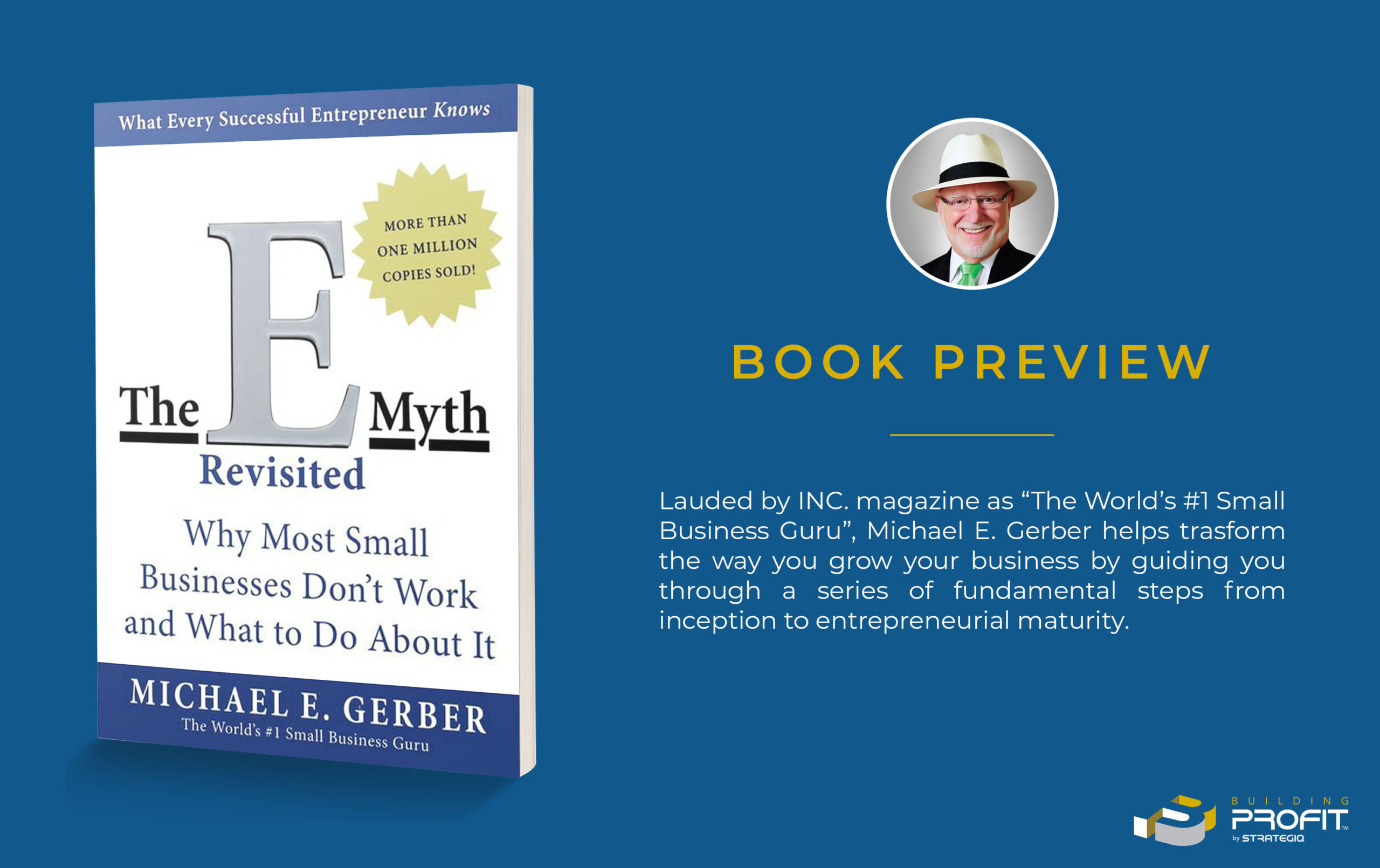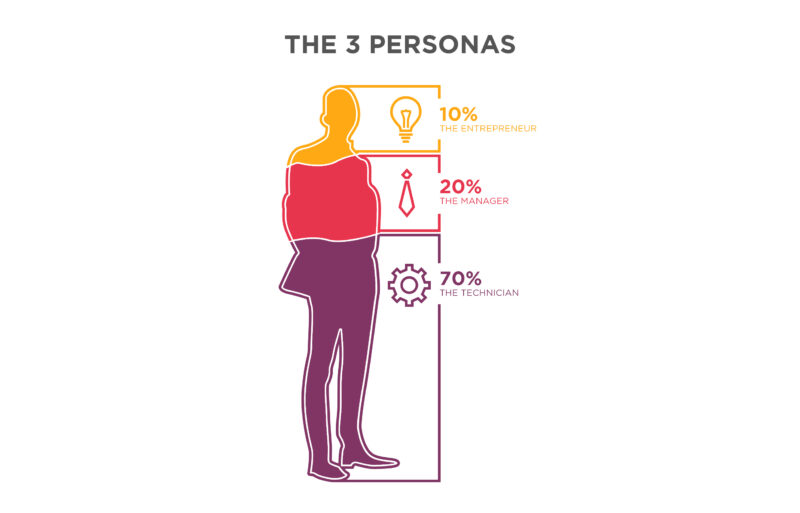Why most small businesses don’t work and what to do about it.

If you own a small business, or you want to own a small business, this book was written for you.
A revised edition of the same principles written over 25 years ago, The E-Myth Revisited aims to dispel the myths about starting up and moving forward with your business venture.
Lauded by INC. magazine as “the World’s # 1 Small Business Guru”, Michael E. Gerber helps transform the way you grow your business by guiding you through a series of fundamental steps from inception to entrepreneurial maturity.
He answers the many questions asked by small business owners as to why their businesses fail, and provides insight into how to rectify these failures to create something extraordinary and rewarding.
Let’s start with the main theme of the book:
The E-Myth
There is a commonly-held misconception that only true entrepreneurs boldly go forth into business. Those who have a natural aptitude for enterprise and a cut-throat commitment to succeed.
This romantic notion that small businesses are started by entrepreneurs, although a popular assumption – is just not accurate.
The majority of small business owners are not business-minded. They start out full of hope and determination, but it all too often ends up being a flash in the pan. They lose their drive and their vision fades to dust. The entrepreneur had only ever existed for a moment.
So, why is it that so many people start their own business, if they’re not true entrepreneurs? Gerber refers to it as:
The Entrepreneurial Seizure
Prior to going into business for themselves, most people have been working for someone else. They have technical skills they use on a daily basis. Perhaps they’re an extremely talented designer or highly-skilled tradesman, for example.
They plod along for a while, showing up to work, using their skills to make money for someone else’s business. Then one day something happens that forces them to question what they’re doing. It could be something obvious like a bad day or a cranky boss. Or something random, like a missed phone call. Whatever the catalyst, they are suddenly stricken with an Entrepreneurial Seizure – the idea that they don’t need to be working for someone else. They know their stuff. They could run their own business! How hard could it be?
Once this light bulb has been lit, there is no turning back. The thought of complete freedom and independence takes over, as the excitement of doing their own thing fuels their determination.
These people invariably fall victim to:
The Fatal Assumption
The assumption is: if you understand the technical work of a business, you understand a business that does that technical work.
But doing the technical work and running a business are two very different things.
The biggest illusion is not seeing it as a business, but still seeing it as a place to go to work.
Rather than freeing themselves to use their skills on their own terms, they become enslaved by having to do a whole lot of extra stuff they have no idea how to do.
They no longer get to enjoy what they’re good at. They become overwhelmed by the added commitments, and thus – the initial enthusiasm and excitement dies.
The success of the business is left wavering.
The 3 Personas

A small business owner takes on 3 roles in one. They are expected to fill the shoes of: The Entrepreneur, The Manager, and the Technician. Inevitably, these roles end up conflicting with each other.
The Entrepreneur: He is the visionary, sparked on by the next great idea, creating endless possibilities. He needs to have the people around him take care of the practical stuff, so that he is free to explore his dream world. He craves control and change.
The Manager: He is the pragmatic planner, maintaining stability and predictability. A stickler for systems and detail, anything that rocks the boat sends him into a spin. He craves order and consistency.
The 2 roles have a symbiotic relationship. One cannot function without the other, even though they contradict each other.
Then there’s –
The Technician: He is the doer. He loves to tinker and pull things apart to examine how to put it all back together again. Getting things done is his game. He likes to work steadily and methodically, one thing at a time. He doesn’t understand thinkers or meddlers. He craves careful consideration for the task at hand.
The Entrepreneur frustrates the Technician because most crazy new ideas don’t work. The Manager frustrates the Technician because they impose too many restrictions on the way things get done.
Small businesses frequently falter because there is no balance between the 3 personas. It is usually 10% Entrepreneur, 20% Manger and 70% Technician.
The 3 Phases of Business Growth

Infancy:
There is excitement and enthusiasm as The Technician dedicates every waking hour to his new business. He is doing what he knows and loves, and is willing to take on all other necessary duties.
During this phase he is the Master Juggler. He works hard and there is satisfaction from doing it all himself.
He creates a reputation for being the go-to business in his trade. He thrives on referrals and the influx of new customers. Everything chugs along smoothly, until … there is too much business and he falls behind. The scales have tipped between supply and demand.
In trying to keep up, the Juggler inevitably drops some balls. All aspects of the business become compromised and ultimately suffer.
He decides to work even harder, doing even longer hours – until burnout sets in. It’s at this point that most small business owners throw in the towel and shut up shop.
The rest go onto –
Adolescence:
This is the point at which the owner decides to get some help. He hires an employee to pick up the slack and do the less desirable tasks.
There is a sense of great relief in handing over the reins, and a new-found freedom in having more breathing space.
The owner observes his employee’s technical competency, so gradually entrusts him with more tasks outside his area of expertise.
Before long, the employee is also swamped and needs help. The business owner would rather delegate the hiring process than do it himself. New staff is hired, but they are not necessarily capable. They need direction and management – something from which the business owner naturally shies away.
Once again, things start to go wrong. Balls are dropped as effective management has not been implemented.
The business suffers. The owner goes back to trying to juggle it all himself.
At this point, thousands of business owners go one of three ways: either they decide to go small again, back to a time when everything was manageable and life was simple, only to repeat the same cycle; or go all out and throw everything they’ve got at it until it self-destructs; or simply exist in survival mode – being consumed by the business day and night, and the possibility of losing it, until they themselves explode.
Only a select few make as far as the next phase, and here is why.
Maturity:
A mature business knows how it got to be where it is, and what it must do to get to where it wants to go.
A business which reaches the maturity stage still passes through infancy and adolescence, but these phases are seen through a very different lens – The Entrepreneurial Perspective.
There is a clear vision from the start of what the business will become, and an objective to make the necessary changes along the way to match that vision.
The Technician has no clear vision for the future, preferring to just plod along in the present and hope for the best. He can only ever see the next step right in front of him.
The mature business owner sees the bigger picture. He anticipates how a series of varying components come together to create a system. He operates under The Entrepreneurial Model – which has less to do with what’s done in a business, and more to do with how it’s done. He aspires to work on his business, not in it.
Gerber explains how the world of business has been revolutionised, detailing the ground-breaking elements that create ultimate success. He looks at how your business should be modelled, and elaborates on the fail-safe methods that should be adhered to. With the right structure and strategies in place, the business should practically run itself.
He also urges you to think about what you truly value in life, and what you want it to look like. To live intentionally, is to pave the way for how you plan your business. It should fit into your life, not the other way around. It’s the only way it will truly survive.

Leave A Comment